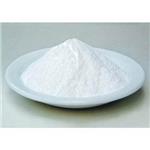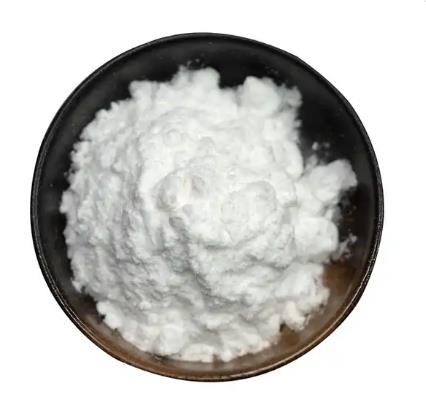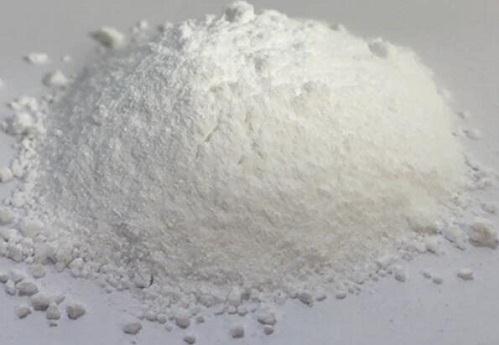The introduction of Glucose oxidase
Penicillium notatum and honey. It can catalyze D-glucose and O2 to produce D-gluconic acid (δ- Lactone) and H2O2. The enzyme of specific penicillium (P. notatum) has attracted attention because of its obvious antibacterial activity. Therefore, it is also known as glucose oxidase (notatin). It is now clear that the antibacterial property is due to the sterilization characteristics of H2O2 generated by the reaction [1]. The purified product contains 2 molecules of FAD. As an electronic receptor, it can react with 2,6-dichlorophenol and indophenol in addition to O2. The enzyme has specificity for glucose.

Figure 1 Appearance of glucose oxidase.
Glucose oxidase is a flavoprotein which catalyzes the oxidation of β-D-glucose to D-glucono-δ-lactone and H2O2 using molecular oxygen as an electron acceptor [2]. This reaction can be divided in to a reductive and an oxidative step. In the reductive half reaction, Glucose oxidase catalyzes the oxidation of β-D-glucose to D-glucono-δ-lactone, which is non-enzymatically hydrolyzed to gluconic acid. Subsequently the flavine adenine dinucucleotide (FAD) ring of Glucose oxidase is reduced to FADH2. In the oxidative half reaction, the reduced Glucose oxidase is reoxidized by oxygen to yield H2O2. The H2O2 is cleaved by catalase (CAT) to produce water and oxygen. Witteveen et al. [3] found the enzyme lactonase (EC 3.1.1.17) in A. niger to be responsible for catalyzing the hydrolysis of glucono-δ-lactone to gluconic acid.
The molecular weight of glucose oxidase ranges from approximately 130 to 175 kDa [4]. Glucose oxidase is highly specific for the β-anomer of D-glucose, while α-anomer does not appear to be a suitable substrate. Low glucose oxidase activities were exhibited when utilizing 2-deoxy-D-glucose, D-mannose and D-galactose as substrates. Inhibitors of glucose oxidase include p- chloromecuribenzoate, Ag+, Hg2+, Cu2+, hydroxylamine, hydrazine, phenylhydrazine, dimedone and sodium bisulphate. Nakamura and Fujiki [5] performed comparative studies on the glucose oxidase of A. niger and P. amagasakiense, and found their molecular weights to be 152 and 150 kDa, respectively. Glucose oxidase produced by both the strains had similar carbohydrates, which consisted mainly of glucose, mannose and hexosamine. A. niger glucose oxidase contained more mannose and hexosamine than that of P. amagasakiense, but less glucose. The overall carbohydrate content was found to be 16% for A. niger and 11% for P. amagasakiense. The amino acid content of two enzymes revealed that the A. niger glucose oxidase contained more histidine, arginine and tyrosine and less lysine and phenylalanine than the P. amagasakiense glucose oxidase. The optimum pH ranges for glucose oxidase from A. niger and P. amagasakiense were shown to be 3.5–6.5 and 4.0–5.5, respectively. It is evident that glucose oxidase from A. niger has a broader pH range than that from P. amagasakiense
Fermentative production
The most common microbial sources for fermentative production of glucose oxidase are Aspergillus, Penicillium, and Saccharomyces species. Most of the commercially produced glucose oxidase is isolated from mycelium of Aspergillus niger, grown principally for the production of gluconic acid or its salts such as sodium gluconate or calcium gluconate. Accordingly, the enzyme is obtained essentially as a by-product or co-product of gluconate production. Petruccioli et al. [6] studied glucose oxidase production by 84 strains of the genus Penicillium and reported that P. expansum (1 strain), P. italicum (1 strain), P. chrysogenum (3 strains) and P. variabile (3 strains), when cultivated on glucose as the carbon source produced glucose oxidase activity ranging from 0.61 U/ml to 5.45 U/ml. The strains mentioned were investigated for their ability to oxidize glucose, fructose, mannose, galactose, arabinose and xylose. Only one of the P. italicum strains (NRRL 983) displayed enhanced oxidizing activity towards mannose, galactose, and xylose being 32.38%, 17.90% and 26.40% compared to glucose (100%), respectively. Hatzinikolaou and Macris [7] investigated different nitrogen sources on the growth and total glucose oxidase activity of A. niger cultivated on sucrose and molasses as sole carbon sources. They found that the peptone concentration had a marked effect on the total glucose oxidase production. With sucrose and molasses as carbon sources, maximum glucose oxidase activity was achieved at 1–2% and 0.2–0.3% peptone, respectively. Liu et al. [8] applied RSM to optimize the speed of agitation and rate of aeration for maximum production of glucose oxidase by A. niger. They found aeration to have a more negative effect on glucose oxidase production than agitation. Significant negative interaction existed between agitation and aeration. RSM was also successfully employed for determination of optimum concentration of media components by Bankar et al [9]. They found maximum glucose oxidase production at 3.08% calcium carbonate, 0.97% peptone and 0.1% magnesium sulphate.
Analysis of glucose oxidase activity
Oxidation of o-dianisidine forms a quinoneimine dye that is measured spectrophotometrically at 500 nm. The benzoquinone can be used for spectrophotometric measurement of glucose oxidase activity. Reaction mixtures containing 1 M glucose, 0.1% benzoquinone, and 0.1 M Na-citrate buffer, pH 5.0 were preincubated at 25 °C and the reaction was initiated by adding the enzyme solution. The method was based on enzymatic reduction of benzoquinone by hydroquinone which was measured by the rate of increase of absorbance at 290 nm [2]. A new assay for glucose oxidase using Fourier transform infrared spectroscopy, was developed and the method was useful to study the kinetic properties of glucose oxidase since the substrate and product of the reaction absorbs at different frequencies. Distinct advantages over coupled assays were the speed of assay, requirement of smaller amounts of substrate and enzyme, and the feasibility of following the reaction by quantifying δ-gluconolactone formation [2].
[2]Bankar et al. Glucose oxidase — An overview. Biotechnology Advances 2009, 27: 489–501.
[3]Witteveen C, Veenhuis M, Visser J. Localization of glucose oxidase and catalase activities in Aspergillus niger. Appl Environ Microbiol 1992;58(4):1190–4.
[4]Kalisz et al. Structural and biochemical properties of glycosylated anddeglycosylated glucose oxidase from Penicillium amagasakiense. Appl Microbiol Biotechnol 1997;47:502–7.
[5]Nakamura & Fujiki. Comparative studies on the glucose oxidases of Aspergillus niger and Penicillium amagasakiense. J Biochem 1968;63(1):51–8.
[6]Petruccioli et al. Distribution and typology of glucose oxidase activity in the genus Penicillium. Lett Appl Microbiol 1993;17:285–8.
[7]Hatzinikolaou et al. Factors regulating production of glucose oxidase by Aspergillus niger. Enzyme Microb Technol 1995;17:530–4.
[8]Liu et al. Optimization of glucose oxidase production by Aspergillus niger in a benchtop bioreactor using response surface methodology. World J Microbiol Biotechnol 2003;19:317–23.
[9]Bankar S, Bule M, Singhal R Ananthanarayan L. Optimization of Aspergillus niger fermentation for the production of glucose oxidase. Food Bioprocess Technol 2008. doi:10.1007/s11947-007-0050-x.
);You may like
Related articles And Qustion
See also
Lastest Price from Glucose oxidase manufacturers

US $10.00/kg2024-04-27
- CAS:
- 9001-37-0
- Min. Order:
- 1kg
- Purity:
- 99.7%
- Supply Ability:
- 200000kg

US $0.00-0.00/kg2024-04-26
- CAS:
- 9001-37-0
- Min. Order:
- 0.10000000149011612kg
- Purity:
- ≥99%
- Supply Ability:
- 20tons



